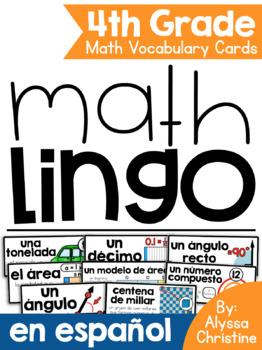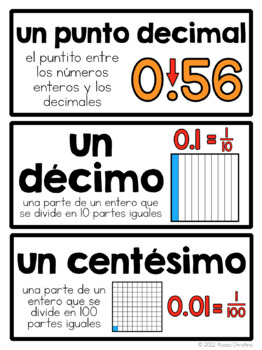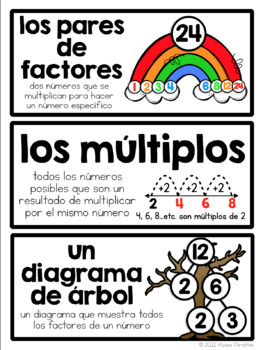4th Grade Math Word Wall in Spanish | Tarjetas de vocabulario para matemáticas
- PDF
What educators are saying
Description
Are you in need of HIGH-QUALITY math vocabulary cards that promote a conceptual understanding of math language IN SPANISH? This pack has exactly that!
This pack contains 145 math vocabulary cards that are aligned with the Common Core Standards for 4th grade along with 6 focus category cards.
***This is the Spanish version of the product: 4th Grade Math Vocabulary Word Wall Cards***
CHECK OUT THE PREVIEW!
Each vocabulary card contains a:
- 4th grade vocabulary word
- Brief, kid-friendly description
- Clear visual that builds a conceptual understanding of the word
Each focus category card contains a:
- Header
- Description of that category in kid-friendly language
- Visual Aid
These vocabulary cards can be used on math word wall or focus wall, in a pocket chart as vocabulary is introduced, or can be put on a binder ring and used as additional support during mini-lessons or small groups.
The math vocabulary words in this pack include:
- redondear
- el valor de posición
- el valor
- la base diez
- una unidad
- una decena
- una centena
- un millar
- una decena de millar
- una centena de millar
- un dígito
- un número de dígitos múltiples
- la forma estándar
- la forma desarrollada
- la forma escrita
- comparar
- mayor que
- menor que
- igual a
- el algoritmo convencional
- reagrupar
- sumar
- restar
- la suma
- la diferencia
- multiplicar
- dividir
- una operación
- una matriz
- una fila
- una columna
- un modelo de área
- una ecuación
- una expresión
- una variable
- los factores
- los pares de factores
- los múltiplos
- un diagrama de árbol
- un número primo
- un número compuesto
- el máximo divisor común
- el mínimo común múltiplo
- el producto
- el cociente
- el dividendo
- el divisor
- el resto
- descomponer
- la comparación multiplicativa
- una estrategia
- un numeral
- un modelo concreto
- un modelo representativo
- un model abstracto
- ser razonable
- estimar
- el cálculo mental
- una regla
- un patrón
- una entrada
- una salida
- las tablas de entrada-salida
- una secuencia
- una fracción
- el numerador
- el denominador
- equivalente
- las fracciones de referencia
- una fracción unitaria
- un entero
- justificar
- un modelo visual de fracciones
- una fracción propia
- un número mixto
- una fracción impropia
- un número entero
- los decimales
- un punto decimal
- un décimo
- un centésimo
- la longitud
- la anchura
- la altura
- la distancia
- la capacidad
- el volumen
- la hora
- el peso
- un kilómetro
- un metro
- un centímetro
- un milímetro
- un gramo
- un kilogramo
- un litro
- una pulgada
- un pie
- una yarda
- una milla
- una onza
- una libra
- una tonelada
- un minuto
- una hora
- un segundo
- una onza fluida
- una taza
- una pinta
- un cuarto de galón
- un galón
- el sistema métrica
- el sistema de EE.UU.
- un vaso de precipitado
- una probeta
- una taza medidora
- una escala
- convertir
- una tabla de conversión
- penny
- nickel
- dime
- quarter
- un dólar
- un diagrama de particiones
- el área
- el perímetro
- un diagrama de puntos
- los datos
- un ángulo
- los grados
- un transportador
- un ángulo agudo
- un ángulo obtuso
- un ángulo recto
- un ángulo llano
- un vértice
- un punto
- una línea
- un rayo
- un segmento
- paralelas
- perpendicular
- intersecarse
- un triángulo recto
- la simetría
- las líneas de simetría
Interested in more?
3rd Grade Math Vocabulary Word Wall Cards IN SPANISH
2nd Grade Math Vocabulary Word Wall Cards IN SPANISH
1st Grade Math Vocabulary Word Wall Cards IN SPANISH
Kindergarten Math Vocabulary Word Wall Cards IN SPANISH
Questions? Email: achristineteach@outlook.com
Thank you!
Alyssa Christine
This work is licensed under a Creative Commons Attribution-NonCommercial-NoDerivatives 4.0 International License.





